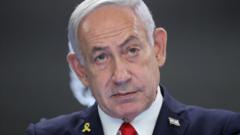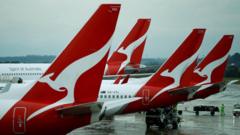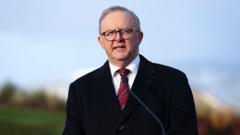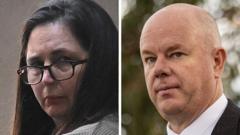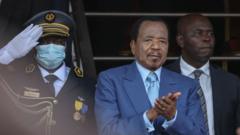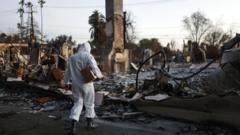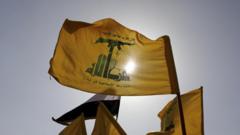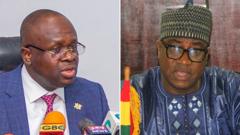Australia is gearing up for a federal election on May 3, 2023, marking a significant moment as Prime Minister Anthony Albanese defends a narrow majority against Peter Dutton of the Liberal Party. This election is expected to revolve around key issues including the cost of living, with both major parties showcasing differing visions for the country's future.
Australia's Federal Election Set for May 3, 2023: A Tight Contest Looms
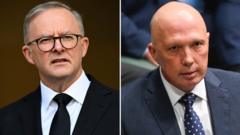
Australia's Federal Election Set for May 3, 2023: A Tight Contest Looms
As the political landscape heats up, Prime Minister Anthony Albanese will face challenges from Peter Dutton in an anticipated close election.
The announcement, made by Albanese from Parliament House, follows opinion polls indicating a competitive race between Labor and the Liberal-National coalition. With the last election resulting in a historic gain for independent and minor party representatives, both leading parties may need to forge alliances with these groups to secure a governing majority.
Prime Minister Albanese emphasized a campaign focused on progress, vowing to tackle rising living costs by proposing initiatives to enhance healthcare access, reduce student debt, and offer tax cuts. He portrayed Dutton's leadership as a regressive choice, arguing that progress requires more than three years to rectify the issues of the previous government: "This election is a choice between Labor's plan to keep building or Peter Dutton's promise to cut."
On the other side, Dutton criticized the current government's handling of the economy, questioning whether Australia is better off now than it was three years ago. He has proposed measures to curb spending and make essential goods more affordable, arguing that the populace deserves relief from economic challenges exacerbated by Albanese's policies.
Meanwhile, the Greens party, which made significant gains in the previous election, is pushing for votes to ensure accountability from the Labor government, spotlighting pressing concerns like climate action and housing affordability. According to Green leader Adam Bandt, discontent towards the major parties paves the way for increased support for third-party initiatives.
As cost-of-living adjustments, housing prices, and healthcare remain top issues for voters, other considerations such as immigration management and crime reduction are gaining traction. The long-standing two-party dominance in Australia means either Labor or the Liberals must win at least 76 out of the 150 seats in the House of Representatives to establish a majority government.
In the backdrop of Albanese’s political career, which emerged after turbulent times marked by frequent leadership changes, he aims to unite the nation and build upon previous climate and social reforms. However, a recent failed referendum regarding constitutional recognition for Indigenous Australians has added pressure, as economic woes persist.
Opposing Dutton, a former police officer with extensive political experience known for his strict conservative policies, presents a challenge for Albanese as both leaders navigate the complexities of voter concerns and national priorities.
In this election, Australians will decide between two contrasting visions, with implications that extend beyond party lines, reflecting broader societal and economic contexts.
Prime Minister Albanese emphasized a campaign focused on progress, vowing to tackle rising living costs by proposing initiatives to enhance healthcare access, reduce student debt, and offer tax cuts. He portrayed Dutton's leadership as a regressive choice, arguing that progress requires more than three years to rectify the issues of the previous government: "This election is a choice between Labor's plan to keep building or Peter Dutton's promise to cut."
On the other side, Dutton criticized the current government's handling of the economy, questioning whether Australia is better off now than it was three years ago. He has proposed measures to curb spending and make essential goods more affordable, arguing that the populace deserves relief from economic challenges exacerbated by Albanese's policies.
Meanwhile, the Greens party, which made significant gains in the previous election, is pushing for votes to ensure accountability from the Labor government, spotlighting pressing concerns like climate action and housing affordability. According to Green leader Adam Bandt, discontent towards the major parties paves the way for increased support for third-party initiatives.
As cost-of-living adjustments, housing prices, and healthcare remain top issues for voters, other considerations such as immigration management and crime reduction are gaining traction. The long-standing two-party dominance in Australia means either Labor or the Liberals must win at least 76 out of the 150 seats in the House of Representatives to establish a majority government.
In the backdrop of Albanese’s political career, which emerged after turbulent times marked by frequent leadership changes, he aims to unite the nation and build upon previous climate and social reforms. However, a recent failed referendum regarding constitutional recognition for Indigenous Australians has added pressure, as economic woes persist.
Opposing Dutton, a former police officer with extensive political experience known for his strict conservative policies, presents a challenge for Albanese as both leaders navigate the complexities of voter concerns and national priorities.
In this election, Australians will decide between two contrasting visions, with implications that extend beyond party lines, reflecting broader societal and economic contexts.

